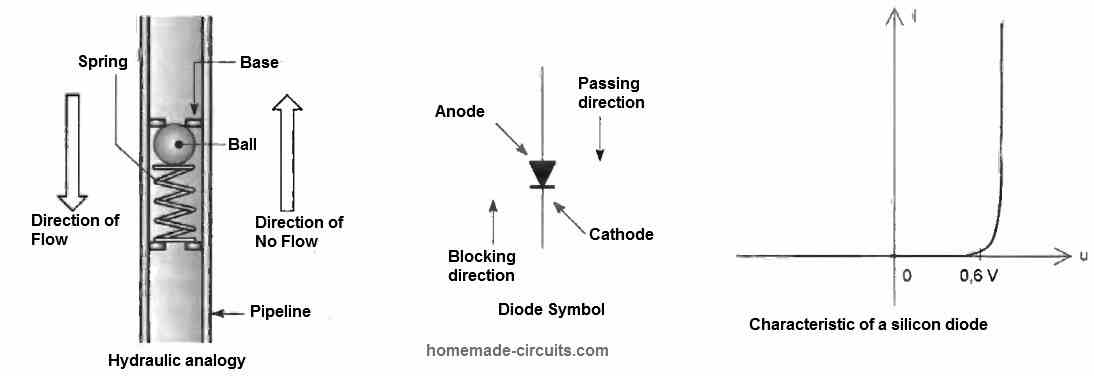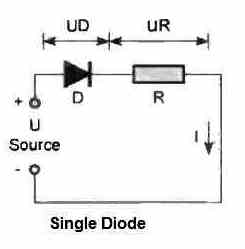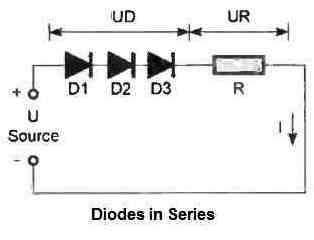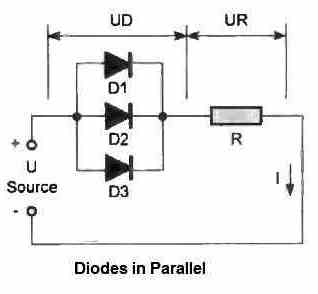It's John Ambrose Fleming (1849-1945), a British engineer, who invented the first diode in 1904, in the form of an electron tube. Later, with the development of semiconductor technology, the diode became a dipole consisting of two substrates: one, rich in free electrons, and of type N, the other deficient in electrons, and of type P.
The diode only allows current to flow in the P-N direction. The doped P part is called the anode, while the cathode corresponds to the doped N part.
General Working
When inserted into a circuit, a diode is in a blocking state if the cathode potential is higher than that of the anode.
However, if the potential is reversed, it can be observed that current only begins to flow if the potential value is greater than a threshold voltage. For typical silicon diodes, this threshold voltage is around 0.6 volts. It is 0.3 volts for germanium diodes and can reach up to 3 volts for light-emitting diodes (LEDs).
This voltage remains almost constant for all current levels crossing the junction, as long as they do not exceed the nominal value for which the diode was designed.
By hydraulic analogy as shown below , the operation of a diode can be compared to a pipeline in which a ball check valve only allows a flow of liquid in the direction where pressure pushes the ball down by compressing a spring.


The "threshold pressure" is the pressure required to neutralize the action of the spring pushing the ball onto its seat.
Direct current behavior - Single diode

Consider a direct current source with a potential of U supplying a circuit consisting of a resistance R in series with a diode D. For a current to be established, it is necessary to satisfy the condition:
U > UD
A potential UD is measured across the diode. In the case of a silicon diode, UD = 0.6 V.
The potential difference across R is given by UR = U - 0.6 V, and the current I is determined by applying Ohm's law: I = UR / R.
The diode D dissipates power P = 0.6 x I.
If the value of I exceeds the nominal limit of the diode, the temperature of the diode increases significantly, which can lead to its destruction.
Diodes connected in series

The establishment of a current is subject to the condition U > 1.8 V (since 3 silicon diodes are connected in series, each having a threshold voltage of 0.6 V). Indeed, the threshold voltages are added in this type of connection.
As explained previously, the value of the potential difference across R can be calculated by applying the relationship:
UR = U - 1.8 V
Similarly, for the current I = UR / R, and the total power P dissipated in the three diodes is 1.8 x I. If the diodes have the same characteristics, the power dissipated by each diode will be one third of the total power.
Connecting diodes in series allows for a fixed potential, which is a multiple of the threshold potential of the diodes, to be obtained. This potential can be used as a reference in certain applications where the current is variable.
Diodes connected in parallel

In practice, a parallel connection of diodes is not useful. Simply because, the current I will flow through the diode with the lowest threshold potential (forward voltage drop). This will result in almost no current flowing in the other parallel diodes.
This implies that one of the diodes would be conducting and allowing the entire current to flow through it, while the other diodes would remain turned OFF. It should be noted that even identical diodes have different manufacturing tolerances, so there will always be differences in the threshold potential.
Hi Swagatam;
I think for instant 1n4001 allows the current up to 1 ampere. However, if they were used 4 pcs of them in a rectifier bridge so that means this rectifier capacity is 2 amperes or what?
My other question is that it is possible to use flyback or shotky diodes to make bridge rectifier?
Best Wishes
Hi Suat,
1 amp is the maximum current handing capacity for 1N4001—1N4007 diodes, but they can start heating up even at 400 mA.
The maximum current handling capacity of a bridge rectifier using 1N4001–1N4007 diodes will be 1 amp only, not 2 amps.
Yes, shottky diodes can be used for making bridge rectifiers.